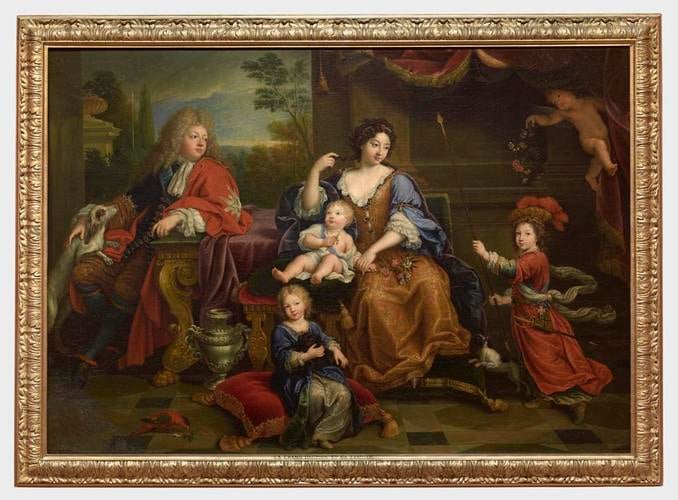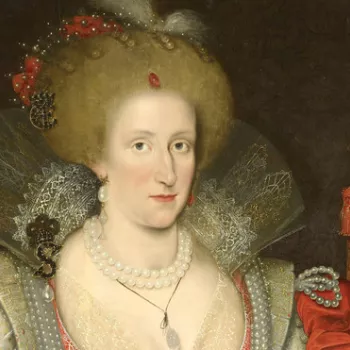Louis, the Grand Dauphin of France with his Family c. 1687
Oil on canvas | 115.2 x 160.1 cm (support, canvas/panel/stretcher external) | RCIN 404490
-
This group portrait, which appears to be a copy after the original at Versailles by Pierre Mignard (1612-1695), combines an air of easy informality with clear indications of the sitters' high status. The Grand Dauphin Louis wears the blue sash of the French chivalric Order of the Saint Esprit (equivalent to the English Order of the Garter), and so too do his three sons: five year-old Louis de Bourgogne, four-year-old Philippe d'Anjou and the infant Charles de Berry, leaning against his mother, Maria Anna Victoria of Bavaria, and otherwise only partially clothed. He clutches an elaborate rattle fashioned from coral, believed in the seventeenth century to have supernatural protective powers. The Dauphin's fashionable shoes include the red block heels (or 'talons rouges') that were only allowable for members of the French aristocracy; his feet are arranged so as to display them to the best advantage, in an elegant posture that mimics the poses taught by courtly dancing masters. Louis de Bourgogne, the Dauphin's heir, upon whom both his affectionate parents' eyes are fixed, similarly adduces courtly elegance to the promise of martial prowess as he plays with a spear opposite his father.
The painting's sense of movement and spontaneity contrasts with the formality of many other representations of the French royal family (Hyacinthe Rigaud's military portrait of the Dauphin was painted in 1688, the year after this painting). This is partly because of the abundance of animals in the picture, who may also have a symbolic significance: the hunting dog looking up at Dauphin models the fidelity due to the father of a household but particularly appropriate to a royal portrait, while the two smaller dogs each mirror the poses of the Dauphin's two elder sons, suggesting lively activity in the case of the older Louis, and affectionate loyalty in that of his younger brother. Meanwhile, the parrot, an expensively imported pet, adds a note of exoticism and attests to Louis XIV's ongoing expansion of French trade routes.
Mignard trained in Paris and Rome, where he became a successful painter of religious scenes, Mignard was peintre ordinaire to Louis XIV from 1663 until his promotion to premier peintre in 1690. He worked extensively on the decorations and statuary of the Chateau of Versailles from 1684 onwards and produced a number of portraits of the king and of his courtiers. The original version of this painting is dated to 1687, when Mignard had just completed his decorative scheme for the cabinet doré of the Grand Dauphin's apartments (now destroyed). The Royal Collection's version was apparently painted shortly afterwards in Mignard's studio; it was acquired by George IV in 1828 as an autograph work.
Louis, Grand Dauphin of France (1661-1711), was the eldest and only surviving son of Louis XIV and his first wife, Maria Theresa of Spain (1638-1683). He married Maria Anna Victoria of Bavaria (1660-1690) in 1680, but, chronically unwell and considered to be dull and unattractive, his wife lived a comparatively isolated existence in a court that prized beauty and vivacity. Through his Spanish mother, the Dauphin had a claim to the Spanish throne: however, when the death of the childless Spanish King Charles II left it vacant in 1700, Louis resigned his Spanish claim in favour of his second son, Philippe (1683-1746). His elder two sons therefore both played prominent roles in the resultant War of the Spanish Succession (1701-1714), a pan-European conflict fought over the international balance of French power.
Groomed for the French throne, Louis duc de Bourgogne (1682-1712) fought unsuccessfully at the Battle of Oudenarde in July 1708 and Philippe duc d'Anjou ultimately ruled Spain as Philip V. By contrast, the Dauphin's youngest son, Charles (1686-1714) spent most of his life at Versailles.
Despite the optimistic picture of succession presented in Mignard's portrait of four healthy French heirs, none of the sitters ever became king of France. Overshadowed throughout his life by Louis XIV, the Dauphin ultimately predeceased him, dying of smallpox in April 1711. His son, Louis de Bourgogne, himself had two sons who survived their first birthday, but his whole family succumbed to a measles epidemic in 1712, and only his youngest boy survived. The Dauphin's remaining son, Charles duc de Berry, died after a hunting accident in 1714, and so, when Louis XIV himself died the following year the French crown skipped two generations and passed to his infant great-grandson, Louis XV (1710-1774).Provenance
Purchased by George IV on 18 July 1828 from Alexis Delahante of Paris as part of a group of four French paintings (402759, 404108, 404410 and 404490) costing £180 in total; added to the Carlton House inventory dated 1819 (no 619)
-
Creator(s)
Acquirer(s)
-
Medium and techniques
Oil on canvas
Measurements
115.2 x 160.1 cm (support, canvas/panel/stretcher external)
127.7 x 175.1 x 4.5 cm (frame, external)
Category
Object type(s)
Alternative title(s)
Louis, the Grand Dauphin of France (1661-1711) with his family
Louis, the Grand Dauphin of France with Princess Marie-Anne-Christine-Victoire of Bavaria and their children.










